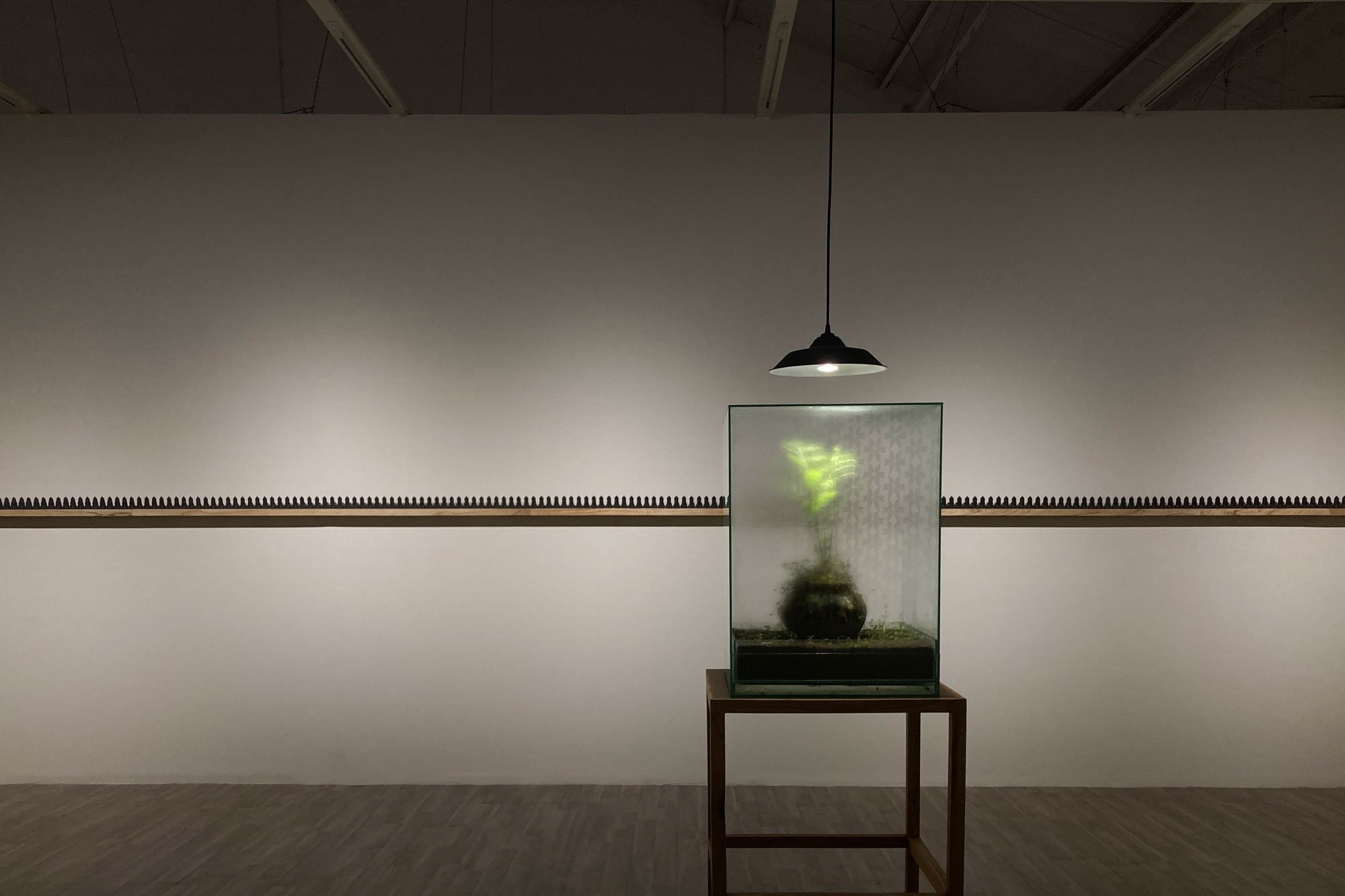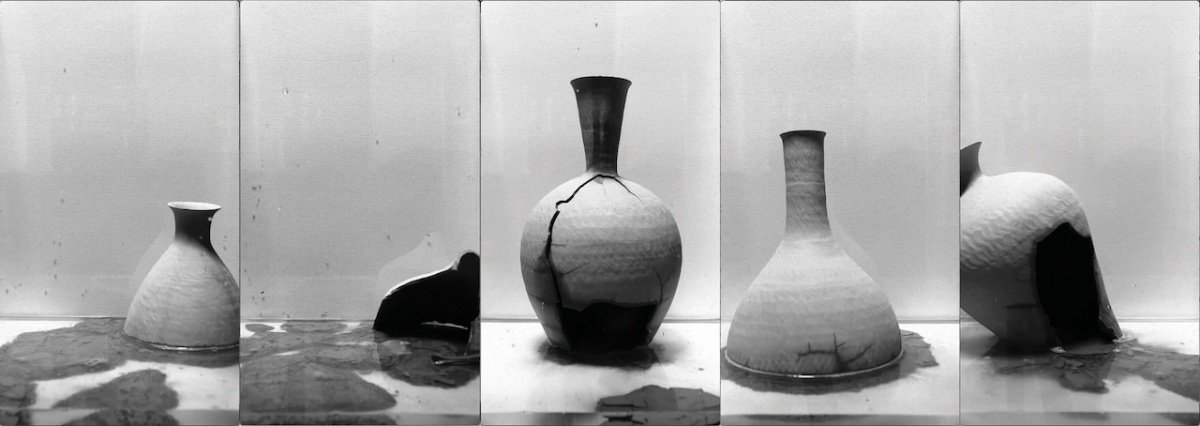There is so much inspiration to be taken from the cycle of life. Every second, something moves, even if we don’t perceive it. While some might argue Time is a social construct, progression is the evidence of our ongoing existence.
Albert Yonathan Setyawan’s work has always had this stoic quality about it that quietens your soul when you approach it, almost as if any unnecessary movement might disturb the unseen energy flowing between his ceramic forms. Our state of awareness is subtly heightened as we are physically dwarfed by the presence of hundreds of ceramic objects crafted by the artist’s hands. What transpires in the space between us? ‘Transitory Nature of Earthly Joy’ is no different; except now there is a movement in the space. Not from us, but from the works.
‘Transitory Nature of Earthly Joy’ at Tumurun Private Museum in Surakarta (Solo) City runs from 8 June 2024 to 12 January 2025. At the point of my visit, the exhibition has been in progress for more than 3 months. Time of visit is seldom a point of concern for visitors, yet here, as the name of the show suggests, your encounters with the work at any point in time presents them in a different state of being. The artist recommends visiting the exhibition more than once to experience their transformations during the 7 month period.
While I was lucky enough to view several of Setyawan’s monumental installations during his survey exhibition “Capturing Silence” in Jogja National Museum (Yogyakarta) last year, those who have missed the show can observe several of his installations and paintings in the collection of the museum on the first floor. Even having seen it before, one cannot help but marvel at its immensity and combined weight of each ceramic piece that might fit in a palm. The presentation of these prior works provide a good context for the transition to the new works, contained in the second floor gallery space.
The 12 new works are an expansion on a previous iteration at the aforementioned exhibition last year, in which 2 urns made of raw clay and other organic material were presented in a clear case containing a controlled environment, encouraging growth in the seeds buried within. The presentation has since been altered to tremendous effect; the source of the water for these individual encased worlds are now almost invisible and the objects sit atop a bed of soil, giving the impression that a slice (or rather, square) of life in the natural world has been carefully removed and contained within clear walls. The sense of witnessing the movement of life becomes more palpable as we put our noses up to the glass foggy with condensation, an inch away from the pill bugs scurrying away with their lives.
First iteration of ‘Transitory Nature of Earthly Joy’ at ‘Capturing Silence’ exhibition in Jogja National Museum in 2023. A tube feeds water through the case which contains the urn, looking like an artefact more than the installations echoing life in the new works.
One understands ceramic as only being complete after the firing process; Setyawan challenges this notion of permanence expected of this ancient medium with his explorations into the destruction— or in this exhibition, undeliberate alteration— of the clay vessel. His video artwork titled ‘Transitory Nature of Earthly Joy’ in 2017 hints at this curiosity to invoke a sense of impermanence using a method that is uncontrollable (in this case, water), having to let go of the tendency to pursue a ‘perfect’ final piece that most who work with mediums of craft origins find pride in. This does not suggest a lack of precision or inadequacy in craftsmanship however; destroying only an object made with care and achieving a certain standard (something fragile, and innocent) evokes that fleeting sense of regret and reflection about the ephemeral quality of life.
Video Still from Transitory Nature of Earthly Joy, 2017. © Albert Yonathan Setyawan. Image courtesy of the Artist and Mizuma Gallery. Image taken from: Monsoonsea.org
In this iteration in 2024, the vessels do not cease to exist completely, but instead presented in an ever-changing state without a final form. The artist acts as an initiator of this ecosystem, involved only with its genesis; the form carries on with life, proliferating in unexpected ways that surprises even its creator.
As an artist who also uses the method of destruction to alter the state of ‘mono-material’ vessels created by hand (in my case, using fire and crochet), I relate strongly with this curiosity that extends beyond the form and technical satisfaction of a piece resulting from precision and control. While our motivations for destruction are different, I find the surprise from the unpredictability of the involvement of a force larger than ourselves (namely, Nature) liberating. Artists and Craftsmen largely differ in that the former sometimes struggle to control the flux in their emotions and expressions; the latter, with letting go of control. In the position of artist practicing in the realm of craft, the balance of control requires immense consciousness to the medium and the voice, which I feel Setyawan has done beautifully.
The new artworks have extended beyond vessels; objects from religious altars familiar to frequenters of Buddhist shrines or temples make up the installations, and is Setyawan’s most obvious reference to a particular entity yet. While his previous iteration in 2023 used urns inspired by those to store ashes post-cremation and hinted at ideas of death and the afterlife, the inclusion of ritualistic objects such as candles, oranges, and a figure of the Bodhisattva is a clear sign to us that the artist is considering the beliefs of the Buddhist religious tradition.
“I have chosen these objects because I think they are a clear and poignant representation of the belief of the afterlife... these objects are usually built to last, commonly believed as representing the connection between our world and the world of the ancestors or the spirits, are juxtaposed using materials that will not last and will continually change over time.”
While we are in the gallery, a slight earthquake tremor causes a quiver; the lamps shake slightly, and the water in beneath the works ripples, despite being in an enclosed tank. We are momentarily shaken from the solemn atmosphere of the gallery, by yet another phenomenon we have no control over. I was struck by how little we seemed at the moment, powerless, just like the bugs and microscopic organisms living within these isolated worlds, experiencing that tremor on a different scale.
I admire the genius of artists who manage to replicate life in the gallery, forcing us to observe and reflect upon the most common and natural phenomenons surrounding us, and which we can so conveniently ignore. Would we normally want to be this close to life, in daily life? Would we want to put our noses so closely to the soil, stare so closely at patches of fungi, if we could smell it? Removing some of the perhaps uncomfortable physical sensations ironically allows us some mental space to access questions of existentiality, rather than just living it.
At times, the work is obscured by the condensation on the glass; frustratingly elusive. We make out a silhouette behind that fog. That inability to clearly perceive nettles the modern human, used to certainty and focus in life and on your screen; this time, this lack of control is experienced by the viewers. This work is meaningful in that it does not tell us what to think, or what it thinks; it just is. We are forced to contemplate the starkness of life and its state of impermanence by putting a glass between us and ‘it’, becoming an observer from the ‘outside’.
This exhibition also includes 3 ceramic installations that are recognizably Setyawan’s; I conclude my visit with the long line of Bodhisattva figures lining one wall of the gallery. Quite small and subtle, I am drawn to it only after repeated observations of the clay-and-soil installations so extraordinarily still yet bustling with life; the Bodhisattva figures are oddly stark and inert after witnessing the wilderness of plants and decay. Yet, walking from one end to the other, you see the barely-there smoothness of an indistinguishable figure gain detail, and it dawns on you the cleverness of the artist at being able to express movement, growth, and transition through objects that by themselves, are in a permanent state.
Ceramic figures on the far-right end of the installation
Ceramic figures on the far-left end of the installation
I believe that artists are translators for the voice within into their medium of expression. The notion of time and progression is difficult to express with with sculpture— something so solid, wordless, and permanent seems to tell you nothing and everything all at once. Setyawan has employed video as a medium in the past, to present the ‘lifetime’ of his vessels as they moved between states of being. In this exhibition, the transition is experienced through the point of active observation, and not through the mode of presentation, which hands the autonomy to the viewers. Watching a video makes us aware we are in the state of witnessing something outside of ourselves; this engagement instead brings forth awareness that what we are observing exists in our very lives.




















